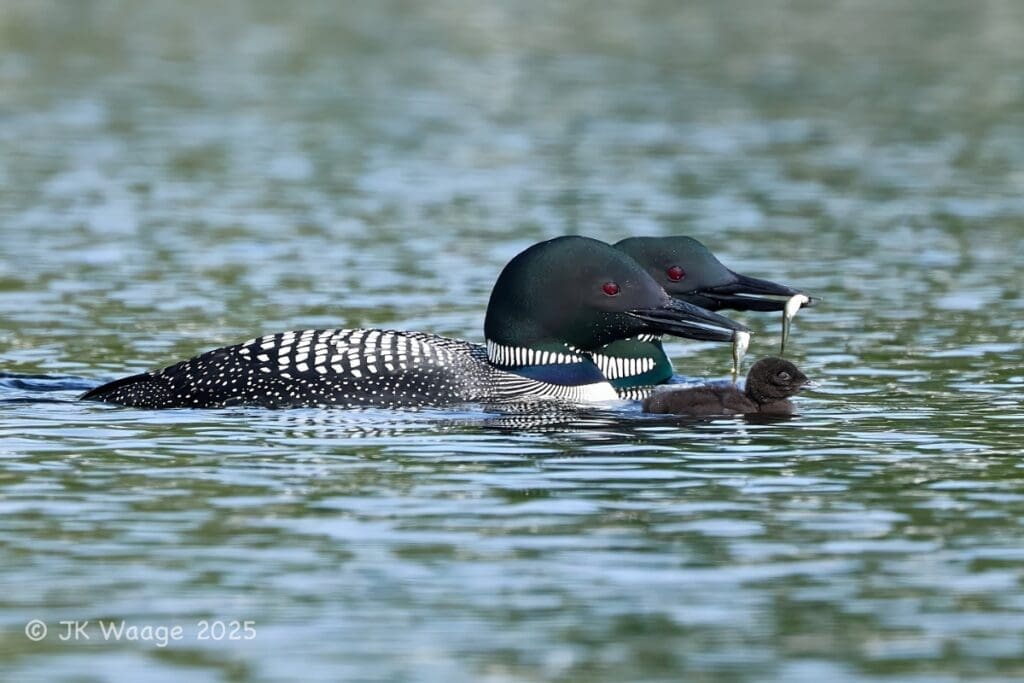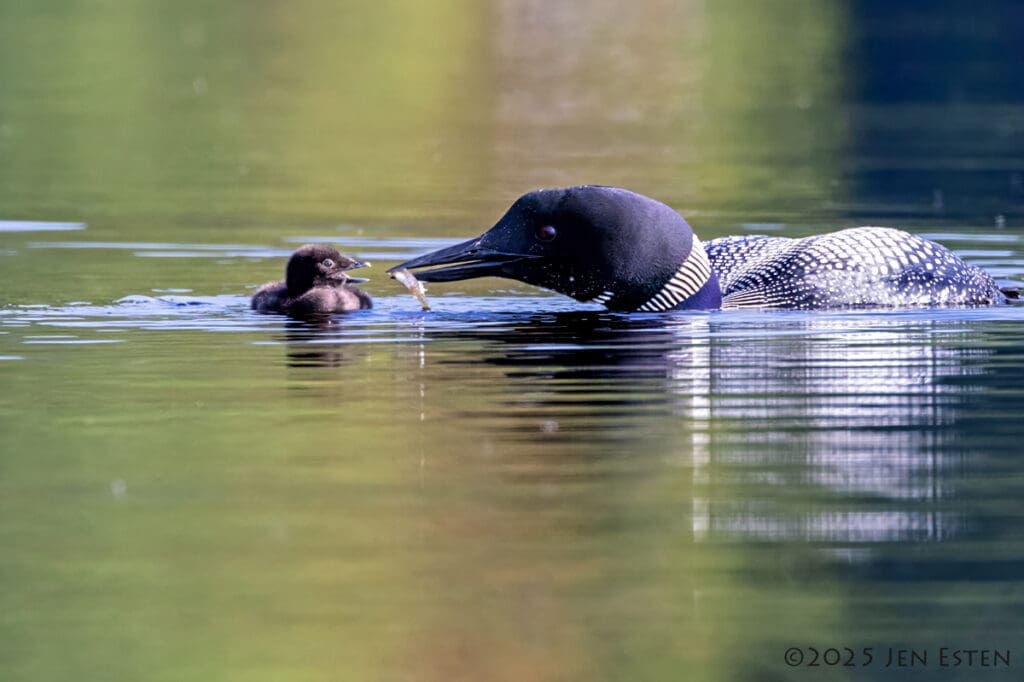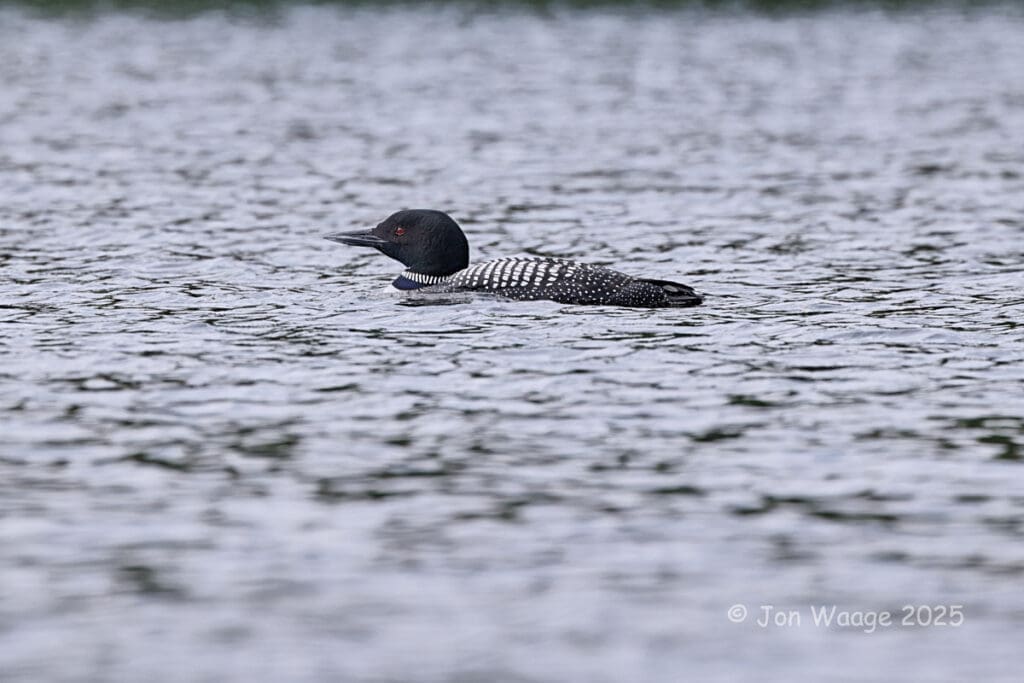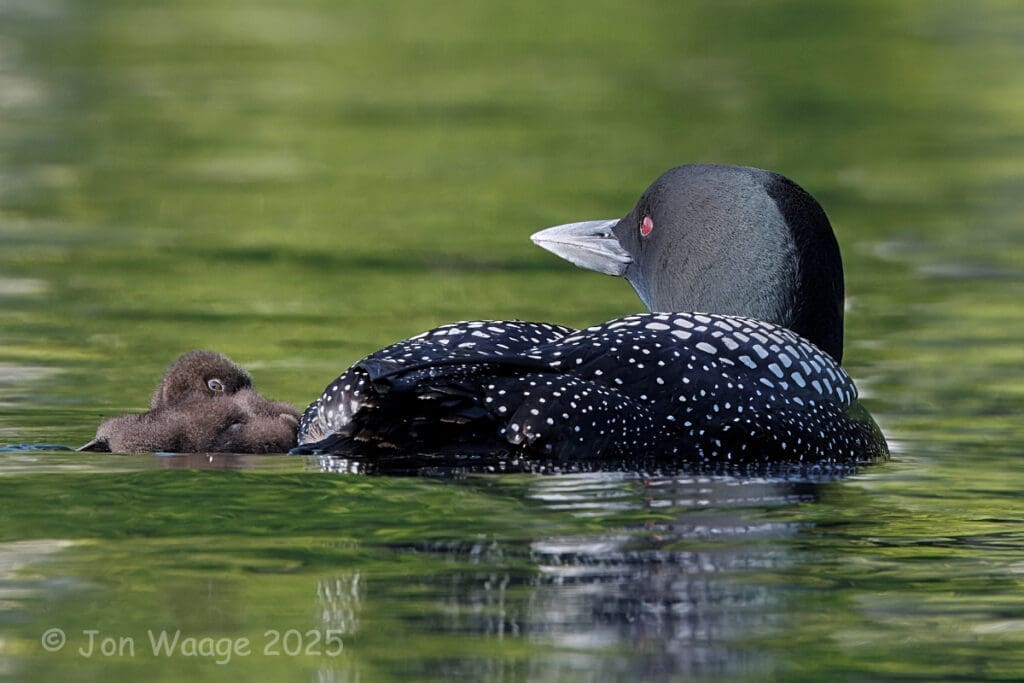Piper is Thriving
2025, No. 05 — June 22nd

|
Well Cared for Loon Chick!
|
At just over a week old, Piper is swimming, diving, and already getting her elongated loon shape.

She is attended to by eager parents who continually bring minnows.

Many are eagerly accepted,

but there are limits!

Otherwise, there is always a free ride and a chance to get warm. Piper’s parents take turns keeping an eye on her between feedings.

|
Dangerous Time for a Loon Chick
|
Piper and her parents are often together near shore, but also spend time out on the lake. That makes them vulnerable, especially when there are waves that make it hard to see a loon from a fast-moving boat.

For a while yet, Piper will be small enough to ride under her parents’ wings. The loon below was at mid-lake. Piper is under his wing. Had he needed to dive to avoid a boat, Piper would have quickly ended up on the surface!

Piper will be spending more and more time alone as her parents look for food or attend to intruders. Please consider going slowly when close to shore and keeping an eye out for a small, brown object. Thank you!

Special note for Pleasant Lake Residents. Monday evening (June 23), a crew from LPC will be here to try and band our adult male. If you see lights flashing around out on the lake after dark, that’s who it is. We hope they can band the male so we can easily identify him in the future. The chick is too young to band at this point. Having clearly marked loons is essential to understanding their biology. We would not have understood the chaotic take-over attempt in 2021 had our female not been banded.
|
A Fascinating Local Native
|
Jack-in-the-Pulpit You’ve probably seen this early-season perennial wildflower and its close relative, Skunk Cabbage, around the lake (and throughout much of Eastern North America). You will encounter it in shady, rich, often moist woodlands. Its pair of leaves, each with three leaflets (thus the name triphyllum), makes it easy to mistake for Trillium or even Poison Ivy. When you find one, look around; there are often more nearby. They may also vary in size from several inches to more than 2 feet.

Jack-in-the-Pulpit (Arisaema triphyllum)
It takes years for a seed to germinate and produce its first set of leaves. Each year, it stores resources in an underground corm. As the corm grows, it can produce a larger plant or even a new one. It is unlikely you have noticed that the different-sized plants you see are different versions of the same plant – Jack-in-the-Pulpit, Jack and Jill in the Pulpit, or Jill in the Pulpit.
When young (small), they have male flowers on the spadix that sits under the canopy of the “pulpit”. As it gets older and larger (and that can take many years), the spadix will have first male and then female flowers. When the plant eventually gets large enough and has enough energy, all of its flowers will be female. If its flowers get fertilized, a cluster of berries, each with 1-5 seeds, will be produced.

Jack-in-the-Pulpit cluster of berries
If that large female plant expends a lot of resources producing berries, it may revert to all male or a mix for a while before becoming all female again. An individual plant can live more than 25 years. Changing sex with age and body condition is a fascinating adaptation shared by many plants, fish, and other organisms.
But that’s not all that is unusual about this plant. How does it get pollinated? It belongs to a large family of plants, the Arums, many of which produce a rather foul odor (think skunk cabbage) that attracts certain insects. In this case, it is fungus gnats that are attracted.
Once they get into the pulpit, they are essentially trapped and will fly around trying to get out. If the plant has male flowers and the gnat lands at the bottom of the pulpit, it can get covered with pollen. At that point, it may find the small hole designed for its escape. Note that the fungus gnat has received no reward for picking up the pollen. In order for a female plant to be pollinated, a once fooled, pollen-covered fungus gnat has to be fooled again. This time, after it bumbles around, accidentally fertilizing flowers while trying to escape, it will never get out because there is no escape hole in a female plant.
Plant-Pollinator interactions are not always mutualistic! We will explore that more in later newsletters. For more details and pictures about Jack in the Pulpits check out this article by Nina Munteanu.
Bye for now … Jen and Jon

Text and Photographs by Jen Esten and Jon Waage
